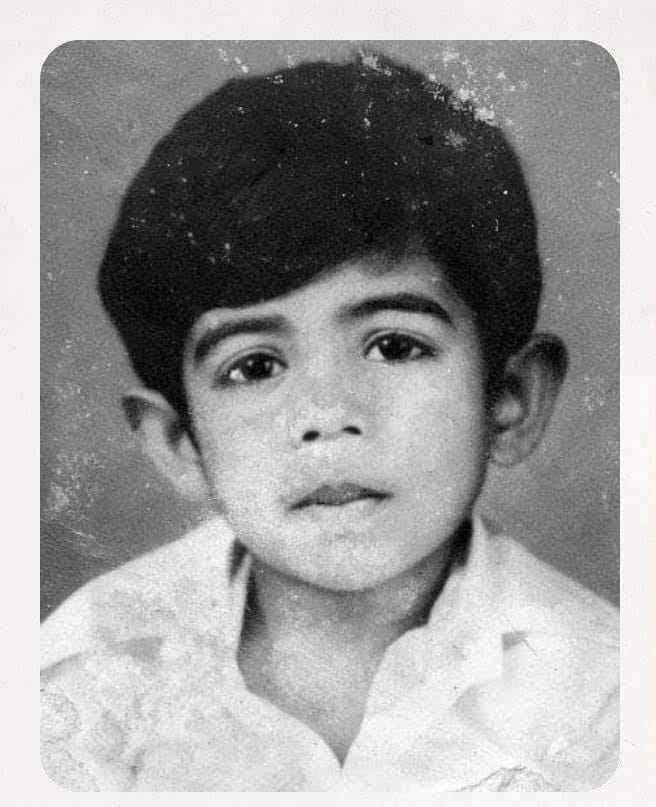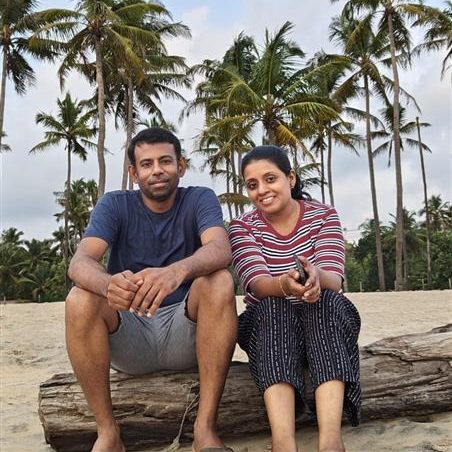Adarsh can walk into a room, and you instantly sense that he belongs. Not because he commands attention in the traditional sense, but because his presence speaks of years of quiet perseverance, passion, and mastery. Adarsh Edathadan Aravindakshan has always been that. As I was reflecting on his ten years with the company, his words are thoughtful, yet not too flashy, humble, yet filled with a sense of quiet pride. “I’m not naturally expressive,” he tells me, a self-aware grin appearing I am assuming. Yet, over the course of our 2 hours conversation (the longest with anyone), I realized that what he thinks he lacks in verbosity, he more than makes up for in substance.

Born in the small village of Aloor in Kerala’s Thrissur district, Adarsh was no stranger to the rhythm of life in a joint family, where laughter and activity were constants. His early years were spent surrounded by the bustle of his grandfather’s oil mill—a business that served as a foundation of relative comfort for the family. But life wasn’t just about business. It was also about the people—the dozens of cousins, aunts, and uncles that made the house feel alive, the games played with friends in the compound, and the simplicity of it all. But like many children of large families, the transition to a smaller, nuclear family setup brought new dynamics. Moving to Nellayi, a quiet village with a highway cutting through it, marked the start of a new chapter. This was where Adarsh began to experience the freedom that would shape his future—though the path was far from clear at the time. “When I returned home after my schooling, it felt like I was experiencing the world for the first time,” Adarsh says, remembering the warmth of his mother, whose support was unwavering. “She didn’t micromanage me, she just wanted me to be happy.”

School, however, had already done its work on him. Boarding school, where Adarsh spent most of his childhood, gave him discipline, a sense of routine, and an adaptability that would later define his approach to challenges. “Living with so many different people taught me how to adjust, how to be flexible in all situations,” he explains. “It made me who I am today.”
In those early years, life seemed to pull him in a variety of directions—most notably, his father’s wish for him to take over the family business. But Adarsh found little passion in the oil mill, a business that seemed both distant and uninspiring. “I didn’t know what I wanted to do. I was just going with the flow,” he admits.

And then, the turning point arrived, as these things often do, unexpectedly.
In the early ’90s, personal computers were still a rarity in many households. Adarsh’s cousin, returning from Mumbai, introduced him to the world of computers—something that captivated him in ways he couldn’t explain. It wasn’t just about games, though that was initially his primary draw; it was the potential of the machine itself, its power to solve problems, and the sense of exploration it offered. “It wasn’t just the games,” he reflects. “It was everything about it—how it worked, how you could make it do what you wanted. It was like a window to a new world and I got trained in it.”

Despite his father’s initial reluctance, a computer was eventually assembled for him—a moment that would change the course of his life. “That computer was a game-changer. I spent hours with it, learning basic programming, exploring memory, floppy disks… it was thrilling. My cousin even started his little training center, probably the first of its kind at our place. People used to be fascinated with the idea of it. I was so passionate about playing games, that I have traveled miles just to get those games with me when people rarely had.” ( I hope Adarsh’s son knows this 🙂 )
This initial exposure ignited a deep passion for technology in Adarsh, a passion that took root despite all odds. He recalls, with surprising modesty, how the first project he undertook was developing custom software for a local DTP center. “I didn’t even know what I was doing at first,” he admits, “but when it worked, I knew that this was my calling.”
Alongside his degree, Adarsh enrolled in a computer course, diving deep into the world of programming post which he joined NIIT, “That’s when I realized that this was where my future was. Programming just clicked for me.” It was about building confidence, and Adarsh soon found himself teaching others. “I was asked to become a faculty member at NIIT after just six months. It was an incredible confidence booster,” he recalls, with a hint of nostalgia.

However, even as he flourished in his newfound career, Adarsh wasn’t quite sure where his professional journey would take him. His early life had been marked by a sense of uncertainty about the future, and even his time at NIIT wasn’t enough to shake that. It wasn’t until an unexpected opportunity in his college days to work as a graphic designer for a small IT company that things really started to come together. “It wasn’t programming, but it was my first IT job, and it gave me a sense of what was possible,” he reflects. It was a moment of realization: this was where his creativity and technical skills could meet.
Fast forward to ten years ago, when Adarsh made a leap that would change the course of his career—he joined Nuvepro. “Leaving a stable job to join a startup was a huge risk, but it was a risk I was willing to take,” he says, his voice tinged with conviction. “I saw in Giri, Rajesh, and Moyukh a team that was determined to build something meaningful. I knew I had the chance to contribute, to build something from scratch.”
And build he did. Today, as the Director of Engineering at Nuvepro, Adarsh looks back on a journey defined not by singular moments, but by consistent growth and the relationships he’s nurtured. “It’s the moments of connection—the daily conversations over lunch, the camaraderie, the challenges, and the triumphs on each day at Nuvepro.
Outside of his professional life, Adarsh’s world is defined by the same principles of balance and connection. “My family has always been my grounding force. My wife, Surya, has been my greatest support. She understands me, and she allows me the space to be myself,” his words imbued with genuine affection. “We share a bond of trust and respect, and that’s what keeps me centered.”
Indeed, it’s the people, and the sense of belonging, that Adarsh credits for his success. His journey has been one of hard work, but also of mentorship, trust, and a shared vision. As his wife, Surya, lovingly puts it, “What I admire most about Adarsh is his ability to balance his professional and personal life with such grace. He’s a fantastic partner who values respect and open communication. Congrats Man!”
Rajesh, a longtime colleague and a friend reflects on their shared history. Over the years, they have worked on countless projects together, but Rajesh speaks most fondly of a memory that speaks to Adarsh’s character rather than his technical skills. “You won’t believe it, but back in the day, Adarsh was already a local hero,” Rajesh tells us. “I remember hearing stories about him in his village—stories of a young boy with a fierce passion for technology. People look up to Adarsh. The core of building a website for their village sticks with him even now.’’ What Rajesh admires most about Adarsh is not just his technical expertise, but his consistency, and his ability to stay grounded while scaling new heights in his career. “He’s the same Adarsh—whether it’s solving intricate problems or mentoring the next generation,” Rajesh continues. “He’s never lost touch with who he is and where he came from.”
The other day, when I spoke to Giri about Adarsh, he couldn’t help but be taken aback by how seamlessly Adarsh blended his way in. “When we decided to bring Adarsh and CP on board at Nuvepro, it was clear to me that there was no reason why someone with his expertise wouldn’t be part of the team. His deep understanding of technology and his pragmatic approach to problem-solving made him a perfect fit. They were too good, I was blown.”

With Adarsh, even in leadership meetings, there’s a sense of quiet strength that stands out. He’s not someone who craves the spotlight or seeks accolades, yet his presence is felt. It’s not the kind of talk that’s loud or flashy, but one that’s built on a steady commitment. He is in simple ways, a genuine man. I’ve realised, Adarsh doesn’t just work with technology—he lives it.
For him, this journey is far from over. I guess, as a techie, he’s attuned to the pace of change, constantly evolving with the times. If the last decade has shown him anything, it’s that the trajectory where the future holds endless possibilities and one just never knows. And as for us Adarsh, we are glad you aren’t the oil mill owner businessman today, but our tech wizard. Oh, yes, and thank you for opening up to me. If I make a non-expressive person speak for 2.5 hours, I humbly take that as a compliment. 🙂
Authored by Shivpriya R. Sumbha | Editorial Reviewer – Anisha K Sreenivasan

